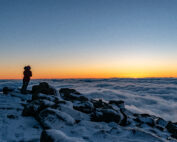NULL
2010-09-27 18:39:40.000 – Jennifer Finn, Summit Intern
NULL
Since the theme of this week seems to be about the anticipation of wintery, ‘bad’ weather and the changing of seasons, I’m going to stick with that. Though the weather hasn’t been too exhilarating, it has been a very exciting forecasting week (for me anyways). The models over the past few days have shown a more winter-like upper air pattern that will prevail for much of the week. Though temperatures aren’t nearly cold enough for snow, it’s reassuring to know that the exciting weather is not too far off. So what exactly does a winter pattern look like, and how does it compare to a summer pattern? There’s one major weather component that drastically affects these patterns and in turn the weather: the jet stream.
Though most of the time ‘the’ jet stream is referred to, there are actually two different jets that affect the weather across the United States: the polar jet and the subtropical jet. In the summer, the subtropical jet is the more dominant. Though winds are can be strong at upper levels, subtropical jets are not as vertically thick as polar jets. There is not much temperature contrast between the north side and south side of the jet at the surface either. A more what is called ‘zonal’ flow is typically seen flowing west to east and bringing warm, moist air over much of the country. Small scale frontogenesis, or the creation and strengthening of fronts, is usually seen, and there are usually no areas of high or low pressure that extend deep into the atmosphere.
In the winter, however, it’s quite a different story. The subtropical jet is pushed to the south as the polar jet begins to dive out of the north. The north-south temperature contrast is much greater than that of the subtropical jet and extends all the way to the surface. This causes for much greater wind speeds. Polar jets extend much higher into the atmosphere than subtropical, and also usher in much colder air from the north. They provide perfect conditions for large scale frontogenesis, and there are larger and deeper areas of high and low pressure that are well defined on weather maps.
So what does this look like on a weather map? The best one to look at to really get a look at what’s going on is to 300 MB Wind and Height map, since that is the level in the atmosphere where the jet streams usually exist. A summer pattern will typically have the subtropical jet extending across the country from east to west. A winter pattern will have the polar jet, as mentioned before, diving out of the north over a large ridge of high pressure in the western part of the country and into a large trough of low pressure in the eastern part of the country. This is exactly the pattern that models have been showing all week, and it is one of the signs that the seasons certainly are changing. I for one can say that I am more than thrilled to see this, and can’t wait to see what the fall and winter seasons have in store!
Jennifer Finn, Summit Intern
From Summit to Sign-Off: My Farewell to the Rockpile
From Summit to Sign-Off: My Farewell to the Rockpile By Amy Cotter Enjoying my last Mount Washington sunset (for now) on September 13, 2025. After two incredible years with the Mount Washington
Trail Report: Seek the Peak Hikes 16 and 17!
Trail Report: Seek the Peak Hikes 16 and 17! By Chris Nichols September 22, 2025 – Summit 16 of 17 A chilly morning turned into a spectacular day on Mount Washington. The thermostat in
From Southern Gulf Beaches to New England Summits
From Southern Gulf Beaches to New England Summits By Mitchell Tsokatos Hi everyone, my name is Mitchell Tsokatos and I am one of the fall interns for the Mount Washington Observatory. Born and raised




